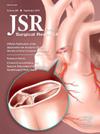V-domain Ig Suppressor of T cell Activation Expression During Hemorrhage or Sepsis-Induced Acute Respiratory Distress Syndrome: Insights From a Mouse Model
IF 1.8
3区 医学
Q2 SURGERY
引用次数: 0
Abstract
Introduction
Acute respiratory distress syndrome (ARDS) is a life-threatening pulmonary condition with significant mortality, largely due to a lack of therapeutic interventions grounded in its molecular pathophysiology. Immune checkpoint regulators, such as the V-domain Ig Suppressor of T cell Activation (VISTA), may provide novel immunotherapeutic strategies for ARDS by modulating the immune response, a concept extensively explored in cancer and autoimmune diseases. Investigating VISTA in the context of ARDS could unveil new therapeutic avenues.
Methods
We used a mouse model of indirect ARDS by subjecting C57BL/6J mice to hemorrhage followed by cecal ligation and puncture. Systemic and localized inflammatory conditions were assessed using samples from blood, lung, and peritoneal fluid. Lung pathology was quantified by scoring hematoxylin and eosin-stained sections. Flow cytometry, enzyme-linked immunosorbent assay, and reverse transcription-polymerase chain reaction analyses concentrated on macrophages, neutrophils, endothelial cells, and epithelial cells to elucidate VISTA expression patterns.
Results
Hemorrhage or cecal ligation and puncture–treated mice exhibited hallmark symptoms of indirect ARDS, including elevated levels of inflammatory cytokines and chemokines. Notably, VISTA expression was substantially upregulated on various cell types, including blood monocytes, lung macrophages, and both circulating and lung-infiltrating neutrophils, as well as on pulmonary epithelial cells and endothelial cells.
Conclusions
Our model replicates critical inflammatory and physiologic changes leading to ARDS, with the elevated expression of VISTA on immune and parenchymal cells suggesting its central involvement in lung injury. The findings propose VISTA as both a potential biomarker for lung damage and as a promising target for ARDS therapy.
求助全文
约1分钟内获得全文
求助全文
来源期刊
CiteScore
3.90
自引率
4.50%
发文量
627
审稿时长
138 days
期刊介绍:
The Journal of Surgical Research: Clinical and Laboratory Investigation publishes original articles concerned with clinical and laboratory investigations relevant to surgical practice and teaching. The journal emphasizes reports of clinical investigations or fundamental research bearing directly on surgical management that will be of general interest to a broad range of surgeons and surgical researchers. The articles presented need not have been the products of surgeons or of surgical laboratories.
The Journal of Surgical Research also features review articles and special articles relating to educational, research, or social issues of interest to the academic surgical community.

 求助内容:
求助内容: 应助结果提醒方式:
应助结果提醒方式:


